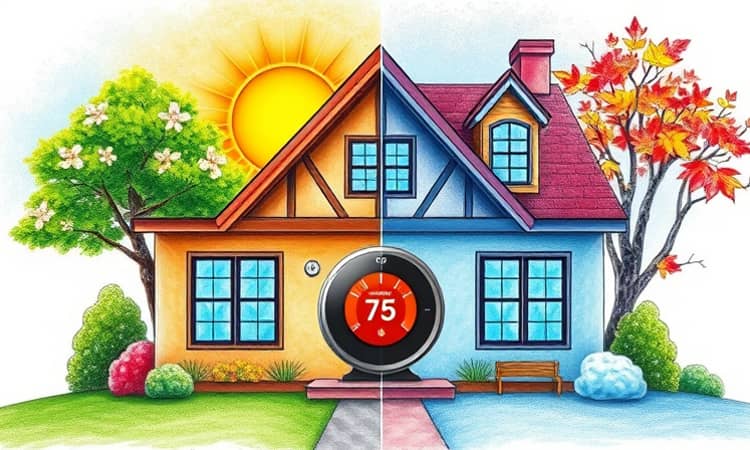Every season brings not only its own beauty but also unique expenses that can strain a household budget. From winter heating bills to summer air conditioning costs, the fluctuations in weather often mirror the rise and fall of our expenses. Yet with thoughtful planning and a few simple adjustments, you can transform these seasonal challenges into opportunities for saving.
By combining time-tested habits with modern tools, homeowners can automate recurring savings transfers and stay ahead of the curve. Whether you’re a seasoned saver or just starting your journey, these tips will inspire you to reclaim a portion of your hard-earned income throughout the year.
General Money-Saving Strategies
Before diving into season-specific advice, laying a strong foundation for your finances can amplify the impact of every tip. Consider these high-level strategies to set you on the path toward financial wellness.
- Set up a high-yield savings account and schedule automatic transfers each payday.
- Track every purchase using spreadsheets or apps to monitor spending with budgeting tools.
- Use cash-back apps like Rakuten and Ibotta to earn rewards on groceries, gas, and clothing.
- Shop bulk sales and second-hand stores to stretch dollars without sacrificing quality.
Beyond these tactics, fostering a mindset of intentional spending and mindful saving can be just as powerful. Celebrating small victories—like reaching a savings milestone or seeing a dropped utility bill—motivates you to stay the course.
Energy-Saving Tips by Season
Heating and cooling account for nearly half of a typical household’s energy expenditure. A small thermostat tweak can yield surprisingly large dividends. Below is a quick reference table for ideal settings:
Adjusting your thermostat by 7–10°F for eight hours each day can save up to 10% on annual energy costs—roughly $83 per household, according to the U.S. Department of Energy.
Modern smart thermostats come with mobile apps and online dashboards that allow you to monitor real-time energy use. By reviewing weekly and monthly reports, you can identify patterns and adjust settings accordingly for even greater savings.
Winter Strategies
When temperatures plummet, your heating system works overtime. Strategic tweaks can keep you cozy without breaking the bank. First, open south-facing curtains during daylight hours to capture natural warmth; close them at night to block drafts. Sealing gaps around windows and doors with caulk or weather stripping also prevents precious heat from escaping.
For drafty windows, consider applying plastic film or upgrading to insulating drapes. When you’re away or asleep, lower the thermostat by 5–10°F to save significant energy. Finally, ensure your heating system receives professional maintenance and remember to close the fireplace damper when it’s not in use—two simple home improvements yield big results.
In addition to sealing leaks, adding area rugs on hardwood floors can help insulate and provide warmth underfoot. Running a humidifier maintains moisture in the air, making lower temperatures feel more comfortable.
Spring Strategies
Spring is a transitional time ideal for maintenance and planning. Start with a thorough energy audit to identify lingering leaks and inefficiencies. Servicing your air conditioning unit early ensures it runs at peak performance when the heat arrives. Replace or clean filters to promote efficient airflow and use ceiling or portable fans to reduce reliance on AC.
This season is also perfect for checking insulation in attics and crawl spaces. Adding a layer of insulation can be a one-time expense that pays dividends every winter and summer thereafter.
Consider landscaping improvements, such as planting shade trees or installing window awnings. These natural solutions can reduce cooling needs in the summer months and add aesthetic value to your home.
Summer Strategies
Summertime often brings soaring cooling bills. By keeping the thermostat at 78°F when you’re home and higher when you’re away, you can maintain comfort and prevent waste. Ceiling fans create a wind-chill effect, letting you feel cooler without overworking your air conditioner.
Try cooking meals on outdoor grills or using microwaves whenever possible to avoid heating the house from stoves or ovens. Sealing air leaks around windows, doors, and ductwork ensures that your AC’s cool air doesn’t escape, further optimizing its efficiency.
Using blackout curtains and reflective window films can block solar heat gain during peak afternoon hours. Additionally, ensure your outdoor HVAC unit is clear of debris for optimal airflow.
Fall Strategies
Fall offers an opportunity to prepare for winter while leveraging milder weather. Schedule a professional tune-up for your heating system before peak season demand. Replace worn weather stripping around doors and windows, and check insulation to prevent cold air from seeping in.
Daylight hours still provide free heat—open curtains during sunny periods and close them at dusk. By taking these steps early, you’ll enjoy consistent warmth and avoid emergency service fees when temperatures drop.
Inspect roofing and attic vents to ensure proper air circulation and prevent moisture buildup. Cleaning gutters and downspouts also protects your home’s exterior and foundation.
Year-Round Efficiency Moves
Beyond season-specific actions, these evergreen practices can continuously trim energy usage and expenses:
- Set your water heater to 120–125°F to avoid overheating and excessive energy consumption.
- Replace HVAC filters every 1–3 months to maintain airflow and system efficiency.
- Dress according to the weather—layering clothes in winter and wearing light fabrics in summer.
- Seal chimney flues and close vents when not in use to prevent heat loss or gain.
- Program your thermostat around daily routines with smart thermostats automate this process for seamless savings.
Implementing these efficiency moves consistently not only lowers bills but also enhances the lifespan of your HVAC equipment, avoiding costly repairs down the line.
Smart Shopping and Extra Tips
A thriving savings plan extends beyond energy bills. Here are creative strategies to cut costs on everyday purchases:
- Remove saved payment details and delete shopping apps to curb impulse buys.
- Join Freecycle and Buy Nothing communities to obtain items at no cost.
- Collect birthday freebies and sign up for loyalty rewards programs for small annual bonuses.
- Plan holiday and gift shopping around major sales—Black Friday, end-of-season clearances, and local promotions.
Embracing a community-driven approach by swapping or borrowing items builds connections and reduces waste. Each unused gift or garment you give away finds a new purpose in someone else’s home.
Building Sustainable Habits for Financial Health
Savings isn’t a one-time event but a set of habits that compound over time. By integrating seasonal energy tips with broader financial best practices, you create a resilient foundation for long-term stability. Consider creating a yearly calendar or planner to remind you of maintenance tasks, shopping events, and budgeting check-ins.
Each small decision—whether lowering the thermostat before bed or automating a savings transfer—contributes to habits yield lasting financial freedom. As you watch your energy bills shrink and your savings grow, you’ll experience the confidence that comes from being in control of your financial destiny.
Let each season remind you of an opportunity: winter’s chill to bundle up and conserve, spring’s renewal to audit and improve, summer’s heat to optimize cooling, and fall’s calm to prepare. With these strategies in hand, you’re ready to maximize your money year-round.
Remember, the key to enduring success is to review your plan quarterly, adjust for changing circumstances, and remain flexible. As the seasons change outside, let your savings strategies evolve inside, too.
References
- https://www.elevatenp.org/energy-efficiency/year-round-energy-saving-tips-to-reach-your-home-efficiency-goals-for-2025/
- https://www.dominionenergy.com/our-stories/energy-saving-tips-for-every-season
- https://booneelectric.coop/education/seasonal-savings-tips/
- https://www.energy.gov/energysaver/fall-and-winter-energy-saving-tips
- https://energysavings.com/blog/advice/seasonal-energy-tips/
- https://www.nerdwallet.com/article/finance/how-to-save-money
- https://www.bankrate.com/banking/savings/ways-to-save-more-this-year-savings/
- https://www.nexamp.com/blog/best-thermostat-settings-for-each-season














